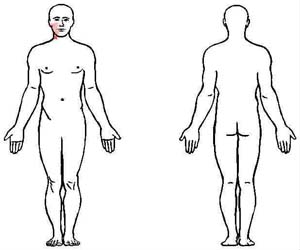
Chiropractor Chandler AZ
Platysma Trigger Point

The platysma muscle has its origin in the subcutaneous tissue of infraclavicular and supraclavicular regions. The insertion points are in the base of mandible, skin of cheek and lower lip, angle of mouth, and the orbicularis oris. The platysma is served by the cervical branch of the facial nerve.
The three trigger points in the neck cause cheek pain, headaches and migraines. The pain, similar to that caused by sinusitis, radiates up from the neck into the cheek area. The images below show the trigger point and the facial area that it affects.
Conservative Treatments
Therapeutic treatments for addressing soft tissue injuries involve massage therapy, manual therapy, trigger point therapy, Graston Technique, or Active Release Technique. These treatments increase blood flow, decrease muscle spasms, enhance flexibility, speed healing, and promote proper tissue repair.
When these treatments are incorporated into a treatment plan patients heal faster and are less likely to have long-term pain or soft tissue fibrosis or scar tissue in the injured muscle. These soft tissue treatments are incorporated with therapeutic exercise and flexibility programs.
Treatment for headache symptoms may involve many prescription, over the counter, herbal, and homeopathic remedies. The neck muscles need to function appropriately and not remain in spasms, which alters neck spinal movements and postures. For those with arthritic degeneration in the cervical spine, restoring proper muscle function is even more important. This often requires people to change their postures, habits, and activities.
Working any muscles in the front of the neck is not comfortable, but it needs to be done to restore proper cervical and shoulder function. The neck, shoulder, scapula, and arm work as a functional unit to turn your head, raise your shoulder, or reach in front of you. Dysfunction in any of these muscles leads to pain and tendinopathy.
TMJ dysfunction can occur with platysma trigger points. People with TMD begin to tighten up and spams many muscles across their face and neck. Conservative therapy relieves muscle spasms that alter the sliding and hinging motions of the TMJ aid in the improvement of TMD.
Acupuncture therapy has been shown to be very effective in muscle injuries to the neck, face, back, shoulder; and can also enhance headache treatments. We have seen several people benefit when they combine traditional TMJ treatments with Acupuncture for the TMJ and facial muscles.
Medical Treatments
NSAIDs are often prescribed for the initial acute injury stages. In severe cases that involve multiple joint regions, muscle relaxers or oral steroids can be given. Trigger point injections, botox, or steroid injections can be treatment options. Pain management is not usually required unless stronger medications or joint injections are required for treatment.
MRI and X-rays will not usually be ordered to evaluate mild to moderate muscle, tendon, and ligament injuries. Severe cases may utilize advanced imaging to rule out bone fractures, edema, nerve entrapments, tendon or muscle ruptures. NCV testing may be utilized in cases that also involve muscle, sensory, or reflex loss.
Cervical spinal disc bulges and herniations onto the spinal cord or nerve root produce different symptoms and location of symptoms. Your chiropractor, physical therapist, occupational therapist, or physician will evaluate your condition and make a proper diagnosis and treatment recommendations. Ask them any questions you might have about your injury.
Conclusion
The upper extremity works as a comprehensive unit performing many of the repetitive tasks at home, work, and recreational sports. Injuries to one area of the musculature often indicate that additional damage has been incurred by other muscles.
Many therapeutic exercises can help restore proper strength and endurance to the elbow flexor muscles. Isometric exercises are often the initial treatment exercises. Followed by single plane rubber band exercises for elbow flexion, extension, pronation, and supination movements. Dynamic exercises involving stability ball push-ups can be performed on the wall or floor. The more unstable of the surface the more effort and stabilization is required of all the upper extremity muscles.
Push-ups on a stability ball enhances neuromuscular learning throughout the neck, scapula, shoulder, upper arm, and lower our muscles. Additional strength exercises can be found on the arm and shoulder strengthening pages.
Our Chandler Chiropractic & Physical Therapy clinic treats patients with a variety of muscle, tendon, joint, and ligament injuries. The clinic provides treatment for runners, tri-athletes, and weekend warriors in addition to common headache, neck, and back patients traditionally seen in Chiropractic, Physical Therapy, Massage Therapy clinics. We work with all ages and abilities of the residents in Phoenix, Tempe, Gilbert, Mesa, and Chandler AZ.